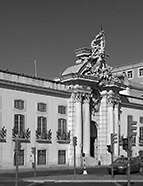

The publication of the Boletim do Arquivo Histórico Militar began in 1930, under the direction of Colonel Henrique de Campos Lima, with the aim of presenting valuable history and military research works, mentioning documents of greater interest contained in the heritage, and publishing the documentary inventories and catalogues prepared by the Archive services. The first document index was published in the first and second volumes (1930 and 1931) concerning the "Military Diplomatic Correspondence of General Bernardim Freire de Andrade, Commander-in-Chief of the Portuguese Army, 1808 Campaign," totalling 117 documents. However, the first catalogue of a complete section would only be published in 1954, in Bulletin no. 24, as the "Catalogue of the Documentary Collection of Brazil, 1st Section of the 2nd Division." Other important works followed, such as the "Map Collection Catalogue," in Bulletin no. 43 of 1973; the "Catalogue of Angola – 2nd Section of the 2nd Division" in Bulletin no. 47 of 1977; the "Inventory of the Fortifications Section – 9th Section of the 3rd Division" in Bulletin no. 50 of 1980; and a special inventory on the Marquis of Pombal, as the "Contribution of the Military History Archive to the commemorations of the bicentenary of the death of the Marquis of Pombal," published in Bulletin no. 52 of 1984. Meanwhile, volumes 25 to 40 of the Bulletin, between 1955 and 1970, published the "Decrees Catalogue of the Extinct War Council, 1640-1834," a work based on the original documentation deposited at the National Archive of Torre do Tombo, carried out by Colonel Horácio Madureira dos Santos, who would become director of the Archive from 1969 to 1971. The bulletin also began to include the director's report, allowing for an annual overview of the funds transferred to the Archive, as well as the document processing works conducted. The annual regularity was generally maintained until the beginning of the 21st century, while its publication has currently been suspended. Sixty-six volumes were published up to 2005.
The role of the Military History Commission, created in 1923, should also be mentioned. Its aim was to "promote the research, acquisition, and publication of military history documents." The Commission was composed of "military and civilian staff competent in military history affairs," and its Central Commission included a general officer as president and eight members, four from the Army, two from the Navy, and two civilians, the latter selected from "employees of the Ministry of Instruction."
